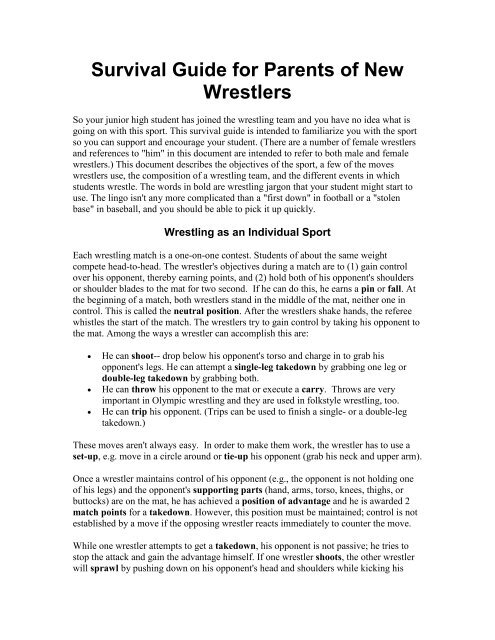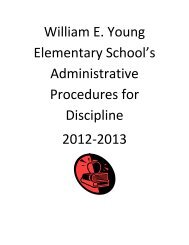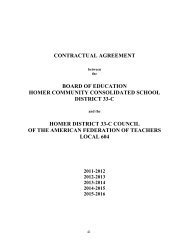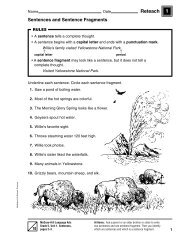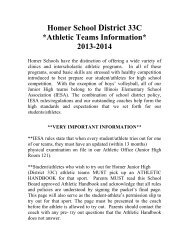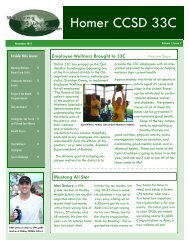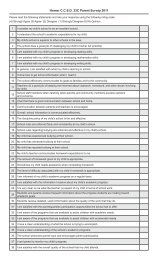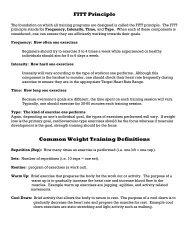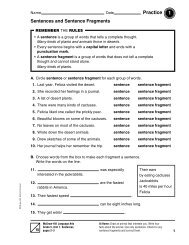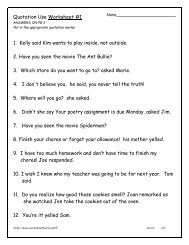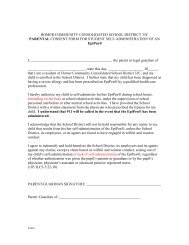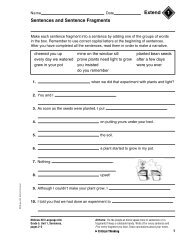Survival Guide for Parents of New Wrestlers - Team Rhino LLC
Survival Guide for Parents of New Wrestlers - Team Rhino LLC
Survival Guide for Parents of New Wrestlers - Team Rhino LLC
You also want an ePaper? Increase the reach of your titles
YUMPU automatically turns print PDFs into web optimized ePapers that Google loves.
<strong>Survival</strong> <strong>Guide</strong> <strong>for</strong> <strong>Parents</strong> <strong>of</strong> <strong>New</strong><br />
<strong>Wrestlers</strong><br />
So your junior high student has joined the wrestling team and you have no idea what is<br />
going on with this sport. This survival guide is intended to familiarize you with the sport<br />
so you can support and encourage your student. (There are a number <strong>of</strong> female wrestlers<br />
and references to "him" in this document are intended to refer to both male and female<br />
wrestlers.) This document describes the objectives <strong>of</strong> the sport, a few <strong>of</strong> the moves<br />
wrestlers use, the composition <strong>of</strong> a wrestling team, and the different events in which<br />
students wrestle. The words in bold are wrestling jargon that your student might start to<br />
use. The lingo isn't any more complicated than a "first down" in football or a "stolen<br />
base" in baseball, and you should be able to pick it up quickly.<br />
Wrestling as an Individual Sport<br />
Each wrestling match is a one-on-one contest. Students <strong>of</strong> about the same weight<br />
compete head-to-head. The wrestler's objectives during a match are to (1) gain control<br />
over his opponent, thereby earning points, and (2) hold both <strong>of</strong> his opponent's shoulders<br />
or shoulder blades to the mat <strong>for</strong> two second. If he can do this, he earns a pin or fall. At<br />
the beginning <strong>of</strong> a match, both wrestlers stand in the middle <strong>of</strong> the mat, neither one in<br />
control. This is called the neutral position. After the wrestlers shake hands, the referee<br />
whistles the start <strong>of</strong> the match. The wrestlers try to gain control by taking his opponent to<br />
the mat. Among the ways a wrestler can accomplish this are:<br />
• He can shoot-- drop below his opponent's torso and charge in to grab his<br />
opponent's legs. He can attempt a single-leg takedown by grabbing one leg or<br />
double-leg takedown by grabbing both.<br />
• He can throw his opponent to the mat or execute a carry. Throws are very<br />
important in Olympic wrestling and they are used in folkstyle wrestling, too.<br />
• He can trip his opponent. (Trips can be used to finish a single- or a double-leg<br />
takedown.)<br />
These moves aren't always easy. In order to make them work, the wrestler has to use a<br />
set-up, e.g. move in a circle around or tie-up his opponent (grab his neck and upper arm).<br />
Once a wrestler maintains control <strong>of</strong> his opponent (e.g., the opponent is not holding one<br />
<strong>of</strong> his legs) and the opponent's supporting parts (hand, arms, torso, knees, thighs, or<br />
buttocks) are on the mat, he has achieved a position <strong>of</strong> advantage and he is awarded 2<br />
match points <strong>for</strong> a takedown. However, this position must be maintained; control is not<br />
established by a move if the opposing wrestler reacts immediately to counter the move.<br />
While one wrestler attempts to get a takedown, his opponent is not passive; he tries to<br />
stop the attack and gain the advantage himself. If one wrestler shoots, the other wrestler<br />
will sprawl by pushing down on his opponent's head and shoulders while kicking his
own his legs back. From this position, he will try to gain control, <strong>for</strong> example by running<br />
behind the other wrestler, or by using a trip or throw. Whichever wrestler gains control<br />
earns two point <strong>for</strong> a takedown and has the position <strong>of</strong> advantage. The wrestler with the<br />
advantage is called the <strong>of</strong>fensive wrestler; his opponent is called the defensive wrestler.<br />
Once a wrestler has the advantage, his goal is to turn his opponent's back to the mat in<br />
order to earn a pin. If one wrestler pins his opponent, the match is over and the <strong>of</strong>fensive<br />
wrestler wins by fall. There are many, many moves that wrestlers use to accomplish this.<br />
The headlock (locking your arms around the opponent's head and one arm), half nelson<br />
(placing your arm under the opponent's elbow and on his head, then lifting the elbow<br />
while pressing the head down), and cradle (locking your arms around the opponent's<br />
head and one knee), are a few you'll see commonly. Some <strong>of</strong> these moves require that the<br />
defensive wrestler be flat on his torso, so the <strong>of</strong>fensive wrestler will <strong>of</strong>ten try to break<br />
him down. If the <strong>of</strong>fensive wrestler turns his opponent and holds his shoulders to the<br />
mat <strong>for</strong> two seconds, he earns a victory by fall. If he cannot accomplish this, but he is<br />
able to expose his opponent's shoulders to the mat <strong>for</strong> longer than reaction time, the<br />
<strong>of</strong>fensive wrestler is awarded a near fall. Holding this position <strong>for</strong> two seconds earns 2<br />
points, while holding it <strong>for</strong> five seconds earns 3 points. These points are also called back<br />
points <strong>for</strong> obvious reasons.<br />
While the <strong>of</strong>fensive wrestler tries to earn back points or get a pin, the defensive wrestler<br />
is busy, too. His goal is to either get free from his opponent's control (called an escape)<br />
or to gain the advantage himself (called a reversal). An escape earns 1 point while a<br />
reversal earns 2. A defensive wrestler can use any number <strong>of</strong> moves, too. He can turn his<br />
back to the <strong>of</strong>fensive wrestler and either sitout or standup by pressing his back against<br />
his opponent's chest, shoulders, or head, or he might try a switch, in which he spins<br />
around the side <strong>of</strong> the <strong>of</strong>fensive wrestler. If the defensive wrestler escapes, then there is<br />
no advantage, and the match continues in the neutral position, just as at the start. If there<br />
is a reversal, the wrestlers pursue their new goals: the new <strong>of</strong>fensive wrestler tries to<br />
turn his opponent and the new defensive wrestler tries to escape or reverse.<br />
While all <strong>of</strong> this is going on, the wrestlers must stay in bounds. If the supporting parts<br />
<strong>of</strong> both wrestlers are out or bounds, the referee will stop the match. If neither wrestler<br />
had as advantage, then the match will resume in the middle <strong>of</strong> the mat just as at the start.<br />
If one <strong>of</strong> the wrestlers had an advantage, then the wrestlers will assume the referee's<br />
position. In this position, defensive wrestler will kneel on his hands and knees, then the<br />
<strong>of</strong>fensive wrestler will squat next to him with at least one knee beside him. The <strong>of</strong>fensive<br />
wrestler will put one hand on his opponent's near elbow, his head on or above his<br />
opponent's back, and wrap the other arm around his opponent's waist. The referee will<br />
whistle to resume the match, and the contestants will continue as be<strong>for</strong>e. Occasionally the<br />
<strong>of</strong>fensive wrestler will use the optional start, in which he stands next to the kneeling<br />
wrestler and places his hands together on his opponent's back.<br />
One other thing about the out-<strong>of</strong>-bounds rules bears mentioning. Sometimes a wrestler<br />
will have his opponent's back exposed or even touching the mat, but he will not be<br />
awarded a fall or near fall. Usually this is because the wrestlers are out <strong>of</strong> bounds. In
order to earn back points or a pin at least a portion <strong>of</strong> BOTH shoulders or shoulder<br />
blades must be in bounds. It is important <strong>for</strong> wrestlers to be aware <strong>of</strong> their location on<br />
the mat, especially when they are near the edge.<br />
After one minute <strong>of</strong> wrestling, the horn will sound and the referee will whistle the end <strong>of</strong><br />
the period. Then the referee will then flip a coin or disk to determine how the second<br />
period will begin. The wrestler who wins the flip may choose any <strong>of</strong> the positions<br />
described above-- the top or bottom positions in the referee's position, the neutral<br />
position-- or he may defer his choice until the third period. If he defers, the other<br />
contestant must choose top, bottom, or neutral. Once the choice is made (usually after<br />
consulting with the coach) the match begins again as described above <strong>for</strong> out <strong>of</strong> bounds.<br />
In the third period, the other wrestler has his choice <strong>of</strong> positions. In addition to<br />
takedowns, reversals, escapes, and back points, penalties points are awarded <strong>for</strong><br />
various technical violations (stalling, locking hands while in the position <strong>of</strong><br />
advantage, fleeing, grabbing clothing, and false starts) and <strong>for</strong> infractions<br />
(unsportsmanlike conduct, unnecessary roughness, and illegal holds). The penalties<br />
<strong>for</strong> these <strong>of</strong>fenses escalate with each occurrence and may lead to disqualification. The<br />
referee also stops the match when a wrestler is injured or a potentially dangerous<br />
situation arises. There are also rules to cover situations when a wrestler is injured or<br />
bleeding.<br />
The match ends immediately when one wrestler achieves a pin, <strong>for</strong>feit, disqualification,<br />
or a technical fall. A tech fall occurs when one player leads by 15 or more points. If the<br />
match comes to its normal conclusion and the difference in score is less than 15 points,<br />
the leader is said to win by decision. A lead <strong>of</strong> 8-14 points constitutes a major decision.<br />
If neither wrestler has a lead at the end <strong>of</strong> the third period, the match has an overtime or<br />
sudden victory period. The wrestlers start in the neutral position, and whoever scores<br />
first wins. If no one scores in the overtime, then a double overtime or tiebreaker period<br />
begins. The wrestler who scored first in the match has the choice <strong>of</strong> top or bottom. The<br />
clock is set <strong>for</strong> 30 seconds. If the defensive wrestler escapes or reverses within 30<br />
seconds, he wins. If he does not, the <strong>of</strong>fensive wrestler wins. A pin is still possible in<br />
both overtime and tiebreaker periods.<br />
Sometimes it can be difficult <strong>for</strong> the new parent to tell which wrestler is in control and<br />
scoring points, but there is a little trick to help you keep track. At the start <strong>of</strong> each match,<br />
one wrestler dons a green ankle band and the other dons or red ankle band. (Sometimes,<br />
<strong>for</strong> dual meets, the ankle bands are not used, but in that case the home team is "green"<br />
and the visitors are "red.") The referee also has a green sweat band on his right wrist and<br />
a red sweat band on his left wrist. When awarding points he raises his arm and holds up<br />
his fingers to show how many points are awarded. He raises the arm with the color<br />
corresponding to the contestant being awarded points. The referee also uses hand and arm<br />
signals to show why the points are being awarded. A diagram showing these signals can<br />
be viewed at the National Federation <strong>of</strong> State High School Associations. By the way, that<br />
disk used to determine choice <strong>of</strong> positions in the second, third, and tiebreaker periods is<br />
also red on one side and green on the other. The <strong>of</strong>ficials, scorers, and timekeepers will
usually refer to the wrestlers only by their color, not by name or team (e.g., the referee<br />
might say, "Green, down," to tell the wrestlers their starting positions.)<br />
Wrestling as a <strong>Team</strong> Sport<br />
<strong>Wrestlers</strong> compete in matches as individuals, but they are also members <strong>of</strong> a team. All <strong>of</strong><br />
the students on the wrestling squad are teammates, but <strong>for</strong> each event, eighteen wrestlers<br />
<strong>for</strong>m a team, one <strong>for</strong> each <strong>of</strong> the weight classes: 65 pounds, 70, 75, 80, 85, 90, 95, 100,<br />
105, 112, 119, 126, 135, 145, 155, 167, 185, 275. In order to qualify to wrestle at an<br />
event, each wrestler will have to make weight, i.e., cannot exceed the weight specified<br />
<strong>for</strong> his class plus any weight allowance that has been agreed to by the teams and the<br />
IESA. Normally each student will only wrestle against students <strong>of</strong> the same weight class<br />
but occasionally a wrestler will bump up a weight class. Each wrestler is trying to earn<br />
team points as a result <strong>of</strong> his match. These are different from the match points described<br />
above. The way these team points are awarded depends on what kind <strong>of</strong> event is being<br />
wrestled. At a dual meet, involving only two teams competing head-to-head, team<br />
points are awarded according to the following table:<br />
Fall, <strong>for</strong>feit, or disqualification<br />
Technical fall (15 or more match points)<br />
Major decision (8-14 match points)<br />
Decision (1-7 points or TB win)<br />
6 team points<br />
5 team points<br />
4 team points<br />
3 team points<br />
The team with the most team points wins the dual meet. Note that sometimes three teams<br />
can arrange a triangular meet, which is essentially a set <strong>of</strong> three dual meets.<br />
Sometimes, however, several teams (ideally 8 or 16) compete together in a tournament.<br />
In that case, scoring gets a little more complicated. Individual awards are given to the<br />
winners and placers in each weight class and the teams also compete against each other<br />
<strong>for</strong> the overall team tournament victory. Be<strong>for</strong>e the tournament starts the matches in each<br />
weight class are posted graphically on a bracket. After the first round <strong>of</strong> matches,<br />
roughly half <strong>of</strong> the wrestlers will have won their matches and continue to the next round<br />
in the championship or top bracket. Those who lose their first round matches continue to<br />
wrestle in the consolation, bottom, or wrestle-back bracket. Round after round,<br />
wrestlers either move on in the top bracket or move to the wrestle-backs. <strong>Wrestlers</strong> who<br />
lose their first two matches are usually eliminated from placing. In the end, there will<br />
only be two undefeated wrestlers left in the top bracket <strong>for</strong> each weight class. They will<br />
wrestle to determine first and second place. The two who remain in the bottom bracket<br />
will wrestle <strong>for</strong> third and <strong>for</strong>th place. (In large tournaments, additional consolation<br />
matches may be held.) Sometimes there will not be enough wrestlers in a given weight<br />
class to fill out all the spots, e.g. when there are 14 contestants in a 16-man bracket. In<br />
that case, one or more wrestlers will receive a bye and move directly to the next round.
In tournaments team points are awarded <strong>for</strong> placement, advancement, and <strong>for</strong> match<br />
per<strong>for</strong>mance. The number <strong>of</strong> placement points awarded depends on the number <strong>of</strong><br />
places the tournament awards. Each tournament may do things a little differently, but<br />
these are the recommended placement points:<br />
1st 2nd 3rd 4th 5th 6th 7th 8th<br />
Four Places 14 10 7 4<br />
Six Places 16 12 9 7 5 3<br />
Eight Places 16 12 9 7 5 3 2 1<br />
In addition, 2 advancement points are awarded <strong>for</strong> each victory in the top bracket<br />
except <strong>for</strong> the final championship match and one point is awarded <strong>for</strong> each victory in the<br />
wrestle-back bracket except <strong>for</strong> the final consolation match(es). If wrestlers receive a<br />
bye in the top bracket and win in their next match, they receive 2 additional team points.<br />
If they receive a bye in the wrestle-back brackets and win their next match, they receive<br />
1 additional point. Match per<strong>for</strong>mance points are awarded <strong>for</strong> each pin, <strong>for</strong>feit, default,<br />
or disqualification (2 points), tech fall (1.5 points), and major decision (1 point). These<br />
are over and above the placement and advancement points.<br />
Well, that should get you started understanding your student's new sport. If you<br />
understand the lingo, that's half the battle. If something isn't clear, just ask your student,<br />
another parent, or one <strong>of</strong> the coaches. The wrestling community is really pretty tightknit,<br />
and new fans who are just learning are usually welcomed with open arms. Have<br />
your student show you some <strong>of</strong> the moves he is learning. It's more interesting to see a<br />
move executed than read about it. You may not know the difference between a crossface<br />
and a cross-body ride (or even care), but this is your student's sport, and he's learning to<br />
love it. He's learning lessons that will serve him his whole life: how to work hard toward<br />
a goal, the value <strong>of</strong> delayed gratification, and self-discipline. He's also gaining selfconfidence,<br />
endurance, and courage. So you stick with him, and with the sport. It will<br />
pay <strong>of</strong>f in the end.


